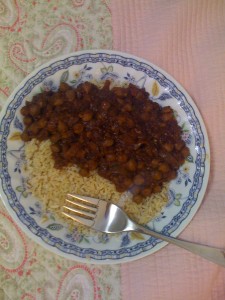I made Punjab choley–again
 A truism of blogging is that you never know what posts are going to get the most hits. Searches on “Punjab choley” have landed me more hits than just about anything other than “matt rouge.”
A truism of blogging is that you never know what posts are going to get the most hits. Searches on “Punjab choley” have landed me more hits than just about anything other than “matt rouge.”
So today I’m writing a new post, this time complete with recipe and a more appetizing photograph of my most recent choley adventure. I cannot promise that my choley is exactly as it is made in the Punjab region; rather, I suspect that, in terms of spices, it probably isn’t. I do believe, however, that most Indians and Pakistanis would enjoy it! Note: I do not use use any butter in my Indian cooking, nor meat, so this receipt is perfect for vegans. In fact, it is an incredibly satisfying dish; you will not miss the animal products in this one!
The basic ingredients
The essence of Punjab choley is
1) Chickpeas (aka, garbanzo beans). Imagine cupping your two hands and filling them with dried chickpeas; that’s about how much I used, soaking them for over a day. They filled your basic steel mixing bowl (I never measure these things out, as you can tell). You can used canned chickpeas, too, but I love the texture of the dried after you’ve cooked the heck out of them; they retain a delightful springy texture to them. And if there is a more economical food than dried chickpeas, then, well, I haven’t found it yet.
2) Tomatoes. I used two cans of diced tomatoes; canned tomatoes are ideal in texture for this dish.
3) Onions and ginger and garlic. I used two large yellow onions (chopped not too fine) and ton of ginger, probably about a quarter of a pound. I julienne the ginger quite fine instead of grating it; it retains a bit of crunch within the dish even after lengthy cooking that pleases the palate. I did not use garlic this time because I didn’t have any, but use as much as you like, chopped or not chopped as you please.
The seasoning
1) Salt to taste. It really doesn’t need much.
2) Hing (asafoetida resin–they’ll have it at your local Indian food store. Important hint: store the opened container in your freezer; otherwise, it will totally stink up a cabinet!). I use a lot of hing in this, but you can completely leave it out if you wish.
3) Dried hot peppers. I threw in a bunch of those little round Indian peppers, but other types will do. You can also leave them out to keep the spice level down: totally a matter of personal preference.
4) Spice blend. You will not go wrong if you just put in a bunch of regular curry powder and a few extra cardamom pods. I typically will use a bunch of G&S curry powder as a base (this may not sound very gourmet, but it is hard to grind certain spices to a fine powder, and this gets in a good base of these upon which to build creatively), add in additional coriander, cumin, fenugreek, ajowan seeds, and cloves that I grind myself. I then throw in cardamom pods and a cinnamon stick whole into the slow cooker. Again, all this is a matter of personal preference, and you can spice it lightly or heavily.
5) Sweetener. You don’t need much, but there should be a bit of sweetness to the dish–just a hint. I use 100% maple syrup; maybe about 1/4 cup.
6) Curry leaves. A few of these can go in at the end of the cooking process (otherwise the flavor disappears; note, however, that the flavor is very strong, so don’t put in too many). These can be hard to find fresh (and that is the only way they come), but they had them Saraga market one day and I bought some. Hint: They freeze very well. They are optional in the dish.
The cooking process
Fry the onion, ginger, and garlic in vegatable oil on low to medium heat until brown and slightly mushy. Put this and everything else into the slow cooker with adequate water (which is to say, you fill it up with water and let it cook down and keep adding water as necessary; the end product, however, should be moist but not soupy) and cook on “high” for about six hours. Check the choley-in-progress from time to time to make sure that you are not burning the dish; not all slow cookers cook at the same rate. At some point you will want to turn the heat down to “low” and cook for an additional period of time: maybe four to six hours, but so long as you are not burning the dish you are not really hurting it, either. If you used canned chick peas, cooking time will be much reduced.
I like to cook the dish until it’s “destroyed,” as I put it. The chickpeas get some mush to them and the color of the spices has completely penetrated them. The tomatoes and onions and ginger and whatnot have all been converted to a tangy sauce for the beans.
Serve over brown rice or a grain mixture of your choice, and I really don’t think there is a healthier, more flavorful, more satisfying, or for that matter more economical meal on the planet. Make a ton, eat heartily, and freeze some portions in those Glad containers for later consumption, and your life will be perfect!
